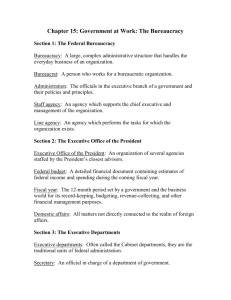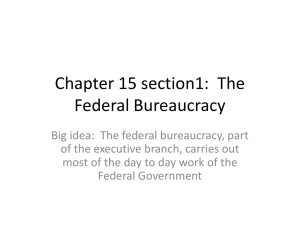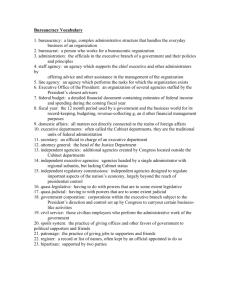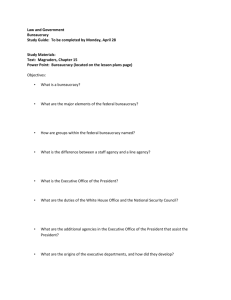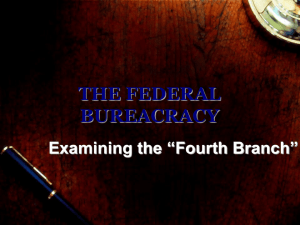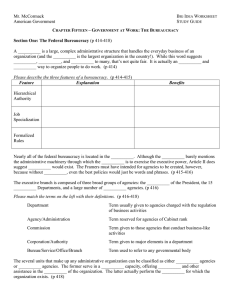PPT - University of San Diego Home Pages
advertisement
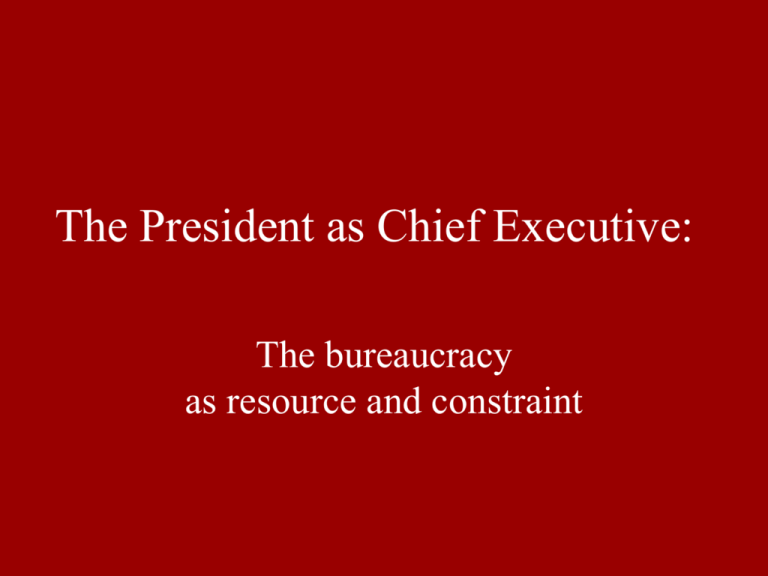
The President as Chief Executive: The bureaucracy as resource and constraint Freewrite How do you think the federal bureaucracy serves as a resource for presidents? How could it constrain what presidents try to do? Should the bureaucracy be mostly a source of expertise that is independent of political control? Or should it be more responsive to direction by the elected Chief Executive? Don’t forget to turn this in for participation credit! Today… • What are the components of the executive branch? • How can the president control the executive branch? – Control who’s running it – Control its budget – Control its output • What are executive orders, and how do they help the president execute the laws? Head of the Executive Branch? One aide said to President Carter, “I have come to the conclusion that there is only one thing you can do, unilaterally, without getting the bureaucracy involved, or having it go through 14 different levels…it’s the only power you’ve got. And he said, “What’s that?” “And I said, ‘You’ve got the power to blow up the world. Can’t nobody stop you…But if you want anything else to happen and you say, I want this done tomorrow, there ain’t very much you can do to get it done tomorrow. Somebody’s got to write a position paper. Somebody’s got to go through this, or you’ve got to check with Congress.” Executive Power “The Executive power shall be vested in a President of the United States of America.” --Article II, Section I “He shall take care that the laws be faithfully executed.” --Article II, Section III Bureaucracy in the Constitution Article II, Section 2: “[the President] may require the Opinion in writing, of the principal Officer in each of the executive Departments, upon any subject relating to the Duties of their respective Offices…” “The Congress may by Law vest the Appointment of such inferior Offices, as they think proper, in the President alone, in the Courts of Law, or in the Heads of Departments.” th 19 • • • • • • • century Cabinet Departments 1789: State, Treasury, War 1798: Navy 1849: Interior 1870: Justice 1872: Post Office 1889: Agriculture 1903: Commerce and Labor – (split in 1913 into Commerce Dept. and Labor Dept.) New th 20 Century Cabinet Depts. • 1947: Defense (from War) • 1953: Health, Education & Welfare – (split into HHS and Education in 1973) • • • • • • 1965: Housing and Urban Development 1966: Transportation 1977: Energy 1979: Education 1989: Veterans’ Affairs 2003: Homeland Security Appointments and Confirmations • 12 cabinet appointments have been rejected: – – – – – – – 1834: Taney 1843: Cushing (three times!) 1844: Henshaw; Porter; Green 1868: Stanberry 1925: Warren (twice) 1959: Strauss 1989: John Tower How can the president control the bureaucracy? • #1: Control who’s running it • • • • Cabinet Secretaries The problem of Bureaucratic Capture Jimmy Carter’s Senior Executive Service Reagan’s Office of Personnel Management How can the president control the bureaucracy? • #2: Control its budget • 19th Century • Bureau of the Budget • Office of Management and Budget How can the president control the bureaucracy? • #3: Control its output: regulations! • Quality of Life Review Program • Council on Wage-Price Stability • Exec. Order 12291—Regulatory Review Terry Moe: The Presidential Advantage? “Even when the interests of presidents and Congress are in conflict, which is much of the time, presidents have inherent advantages in the realm of institution building that allow them, slowly but surely, to strengthen their hand in the ongoing battle with Congress for control of the bureaucracy.”
